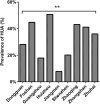Prevalence and Risk Factors Associated with Hyperuricemia in the Pearl River Delta, Guangdong Province, China
- PMID: 33623455
- PMCID: PMC7896760
- DOI: 10.2147/RMHP.S293913
Prevalence and Risk Factors Associated with Hyperuricemia in the Pearl River Delta, Guangdong Province, China
Abstract
Background: In China, the prevalence of HUA in the Pearl River Delta (PRD) region of Guangdong Province has not been extensively investigated. Therefore, this study investigated the prevalence of HUA and its related factors among people aged 20-99 years in nine cities in the PRD.
Materials and methods: We selected 6491 health check participants from 9 cities in the PRD and collected participants' anthropometric and biochemical test results for a cross-sectional study. We included 6491 participants and assessed their blood pressure (BP), body mass index (BMI), total cholesterol (TC), triglycerides (TG), glucose (Glu) and serum uric acid (UA) to analyze the regional prevalence of HUA and its related factors. HUA was indicated when fasting serum UA level was >420 μmol/L in men and >360 μmol/L in women.
Results: Overall prevalence of HUA in our cohort was 34.05%; prevalence was higher in men than in women (41.53% vs 26.14%, P < 0.001). Characteristics associated with HUA were hypertension (odds ratio (OR), 5.506; 95% confidence interval (CI), 4.402-6.889), higher body mass index (BMI; OR: 1.746; 95% CI: 1.560-1.954), age 31-40 years (OR: 0.829; 95% CI: 0.706-0.973), age 61-70 years (OR: 1.434; 95% CI: 1.194-1.722) and age ≥71 years (OR: 1.742; 95% CI: 1.397-2.173). In all subjects, serum UA was positively correlated with Glu, TG and TC. After we adjusted for age, BMI and BP, multivariate logistic regression analysis showed that HUA risk factors were high TC (OR: 1.770; 95% CI: 1.459-2.147) and TG (OR: 1.961; 95% CI: 1.632-2.357) in men; and high Glu (OR: 1.508; 95% CI: 1.084-2.099), TC (OR: 1.341; 95% CI: 1.084-1.660) and TG (OR: 1.680; 95% CI: 1.290-2.187) in women.
Conclusion: The prevalence of HUA was relatively high in the PRD of Guangdong Province. Relevant governmental bodies should focus on early diagnosis, early treatment and early intervention.
Keywords: cardiovascular diseases; hyperuricemia; prevalence; risk; uric acid.
© 2021 Liu et al.
Conflict of interest statement
The authors declare that they have no competing interests.
Figures
Similar articles
-
Triglycerides and Total Cholesterol Concentrations in Association with Hyperuricemia in Chinese Adults in Qingdao, China.Risk Manag Healthc Policy. 2020 Mar 2;13:165-173. doi: 10.2147/RMHP.S243381. eCollection 2020. Risk Manag Healthc Policy. 2020. PMID: 32184687 Free PMC article.
-
Changes in the prevalence of hyperuricemia in clients of health examination in Eastern China, 2009 to 2019.BMC Endocr Disord. 2022 Aug 10;22(1):202. doi: 10.1186/s12902-022-01118-z. BMC Endocr Disord. 2022. PMID: 35948906 Free PMC article.
-
[The prevalence of hyperuricemia in Xinjiang Kazaks in Fuhaii].Zhonghua Nei Ke Za Zhi. 2015 Nov;54(11):931-5. Zhonghua Nei Ke Za Zhi. 2015. PMID: 26922820 Chinese.
-
Survey on uric acid in Chinese subjects with essential hypertension (SUCCESS): a nationwide cross-sectional study.Ann Transl Med. 2021 Jan;9(1):27. doi: 10.21037/atm-20-3458. Ann Transl Med. 2021. PMID: 33553320 Free PMC article.
-
Demographic, regional and temporal trends of hyperuricemia epidemics in mainland China from 2000 to 2019: a systematic review and meta-analysis.Glob Health Action. 2021 Jan 1;14(1):1874652. doi: 10.1080/16549716.2021.1874652. Glob Health Action. 2021. PMID: 33475474 Free PMC article.
Cited by
-
Efficacy of Chinese herbal medicine Jiangniaosuan formula for treatment of hyperuricemia: study protocol for a double-blinded non-inferiority randomized controlled clinical trial.Trials. 2022 Jan 3;23(1):1. doi: 10.1186/s13063-021-05959-2. Trials. 2022. PMID: 34980237 Free PMC article.
-
Adherence to DASH Dietary Pattern and Its Association with Incident Hyperuricemia Risk: A Prospective Study in Chinese Community Residents.Nutrients. 2022 Nov 16;14(22):4853. doi: 10.3390/nu14224853. Nutrients. 2022. PMID: 36432539 Free PMC article.
-
Multimodal Machine Learning-Based Marker Enables Early Detection and Prognosis Prediction for Hyperuricemia.Adv Sci (Weinh). 2024 Sep;11(34):e2404047. doi: 10.1002/advs.202404047. Epub 2024 Jul 8. Adv Sci (Weinh). 2024. PMID: 38976552 Free PMC article.
-
Study on risk factor analysis and model prediction of hyperuricemia in different populations.Front Nutr. 2024 Oct 14;11:1417209. doi: 10.3389/fnut.2024.1417209. eCollection 2024. Front Nutr. 2024. PMID: 39469332 Free PMC article.
-
The prevalence and risk factors of hyperuricemia in patients with Newly-diagnosed coronary artery disease from 2017 to 2021.BMC Cardiovasc Disord. 2025 Aug 21;25(1):620. doi: 10.1186/s12872-025-05093-w. BMC Cardiovasc Disord. 2025. PMID: 40841883 Free PMC article.
References
LinkOut - more resources
Full Text Sources
Other Literature Sources
Miscellaneous





